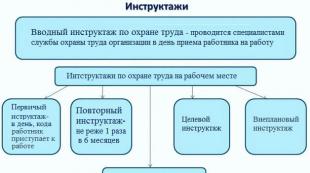The principle of operation of the evaporator. Installation of compressor and condenser units (KKB)
Units with support posts are checked for horizontality and fixed with foundation bolts, after which the unit is tied with pipelines, a control check of shaft alignment, installation of power cables, electrical equipment and automation devices. Installation ends with individual tests in idle and under load.
The installation of the evaporator is started disassembled: tank, panels, manifolds, agitators, liquid separator. The tank is checked for tightness, panels are checked for verticality, collectors for horizontality. The mixer is tested. Then a liquid separator is mounted on a separate platform. The tank is thermally insulated from the outside, the assembled evaporator is subjected to individual testing.
Installation of batteries and air coolers
Air cooler (H/O)
For fastening suspended in / s during the construction process, metal embedded parts are provided between the floor or floor slabs. But since the location of the air coolers may not coincide with the embedded parts, a special metal structure is additionally provided.

The installation ends with individual H/O tests, which include a run-in of the fan and, if necessary, a test for the strength and density of the pipe space. Post-mounted in / about can be installed either on the foundation supports, or when placed on mezzanines on metal supports. Installation includes installation in the design position, alignment, fixing, supply of cold water pipelines, laying of a drainage pipeline, supply of electrical cables.
Battery
Can be ceiling, wall. For fastening ceiling batteries, embedded parts are used. Batteries are made up of sections and can be collector and coil. I test for density and strength with the entire system.

Installation of aggregated equipment
Before installation, the readiness of the premises, the foundations, the completeness and condition of the equipment, the availability of technical documentation are checked. Units can be placed either in one room, the engine room, or dispersed in utility rooms. In the latter case, there should be no more than 0.35 kg per 1 m 3 of the room (eg R22). The room must be equipped with a ventilation system. It is forbidden to install units on landings, under stairs, in corridors, in lobbies, in foyers.
The following must be observed in the engine room:
1. The width of the main passage is at least 1.2 m;
2. Between the protruding parts of the equipment is not less than 1 m;
3. The distance between the unit and the wall is at least 0.8m.
Shields with fittings are placed on the wall near the unit.
The pipelines are laid with a slope that ensures the return of oil to the compressor crankcase. The thermostatic expansion valve is installed with the capillary tube upwards.
The condensing units come from the factory filled with coolant, so they are switched off before testing the system for density and strength.
Pipeline installation
When laying pipelines, a sleeve is installed in the wall, with a diameter of 100-200 mm more than the diameter of the pipelines.

Depending on the environment and operating conditions, pipelines are divided into: A - highly toxic; B-fire and explosion hazardous; B-everyone else.
Depending on the categories, different requirements are imposed on pipelines in relation to: assortment, fittings, type of connection, quality control of the weld, test conditions. Eg. For ammonia use seamless steel pipes, which are connected to shaped sections and to each other by welding, and to equipment and fittings using flange connections (thorn groove, protrusion-trough). For freon HM are used copper pipes, which are comp. among themselves by soldering, and with equipment, fittings using a conn. nipple-fitting-swivel nut.
 |
For coolant and water, steel pipes welded with a longitudinal seam are used. Between each other using threaded connections.
When laying water pipelines in the ground, their intersection with electrical cables is not allowed. Pipelines are made on the basis of assembly diagrams and drawings, as well as specifications for pipes, supports, hangers. The drawings contain the dimensions and material of pipes and fittings, fragments of ties to equipment, installation locations for supports and hangers. In the room, the route of pipelines is broken, i.e. marks are made on the walls corresponding to the axes of the pipelines, along these axes the installation sites of attachment points, fittings, compensators are marked. Brackets and embedded parts for fastening are installed and poured with concrete. Before installing the pipelines, all equipment must be installed, since the installation of pipelines starts from the equipment. Assemblies are lifted onto fixed supports and fixed at several points. Then the assembly is attached to the equipment nozzle, calibrated and pre-fixed. Then a straight section is attached to the node by tack welding. The assembled section is checked for straightness and the assembly joints are welded. In conclusion, a control check is carried out and the pipeline section in the conn. finally fixed. After installation, the pipelines are blown with compressed air (water-water) and tested for density and strength.
Installation of air ducts
 In order to unify the location of the air ducts relative to building structures recommended mounting positions should be used:
In order to unify the location of the air ducts relative to building structures recommended mounting positions should be used:
Parallelism a 1 \u003d a 2

Distance to walls (columns)
X=100 at =(100-400)mm
X=200 at =(400-800)mm
X=400 at 800 mm
The minimum allowable distance from the axis of the air ducts to the outer surface must be at least 300 mm + half. Options for laying several air ducts relative to the horizontal axis are possible.

Distance to the outer wall (from the axes of the air ducts)

![]()
 - the minimum allowable distance from the axes of the air ducts to the ceiling surface
- the minimum allowable distance from the axes of the air ducts to the ceiling surface
When passing air ducts through building structures, detachable connections. air ducts should be placed at a distance of at least 100 mm from the surface of these structures. Air ducts are fastened at a distance of no more than 4 meters relative to each other, with a diameter or dimensions of the larger side of the air duct less than 400 mm, and no more than 3 meters for large diameters (horizontal uninsulated on flangeless connections), at a distance of no more than 6 m with a diameter of up to 2000 mm (uninsulated horizontal metal air ducts on a flange connection)
Connection methods. air ducts:
Flange connection;

Telescopic connection;

1,2 - riveted parts; 3 – rivet body; 4 – rod head; 5 – stress concentrator; 6 - emphasis; 7 - collet; 8 - rod. Collet 7 pulls rod 8 to the left. The stop 6 presses the rivet 3 against the parts to be riveted 1,2. Stud head 4 flare rivet 3 with inside and with a certain force, the rod 8 tears it off.
bandage connection;
 1 bandage
1 bandage
2-gasket
3-connect. air ducts
Operation and service of SCR
After the systems are delivered to the customer, their operation begins. SCR operation is the constant use of the system during its normal operation in order to create and maintain the specified conditions in the serviced objects. In the course of operation, the system is turned on, maintenance is carried out, the required documentation is drawn up, registration in the operating parameters logs, as well as comments on operation. Ensuring uninterrupted and effective work SLE carry out operation services in accordance with the instruction manual. They are incl. includes: terms of maintenance, preventive inspection, repairs, terms of delivery of spare parts, instructions and materials. SCR is also used by system diagrams, short work certificates, project deviation certificates, technological passports for equipment. Before putting into operation of SCR, they are tested and adjusted. Tests incl. individual testing of installed equipment, pneumatic testing of heating and cooling subsystems, as well as air duct systems. The test results are documented in the relevant act. The purpose of the work on the adjustment of SCR yavl. Achievement and stable maintenance of the set parameters with the most economical mode of operation of all systems. During adjustment, the operating parameters of the system are set in accordance with the design and standard indicators. In the process of system maintenance, the technical condition of all equipment, the placement and serviceability of control devices and instrumentation are checked. According to the results of the check, a defective statement is compiled. If the installed equipment corresponds to the project, then all systems are tested and adjusted in the next. sequences: - adjustment of all functional blocks of the Central Committee to bring it to the design parameters; - aerodynamic adjustment of the system for the design air flow rates along the branches; - testing and adjustment of the source of heat and cold, pumping station; - adjustment of fan coil systems, air coolers and air heaters of the Central Committee; - measurement and verification of indoor air parameters with normative.
→ Installation of refrigeration units
Installation of main devices and auxiliary equipment
The main devices of a refrigeration plant include devices that are directly involved in mass and heat transfer processes: condensers, evaporators, subcoolers, air coolers, etc. Receivers, oil separators, dirt traps, air separators, pumps, fans and other equipment that is part of a refrigeration plant include to ancillary equipment.
The installation technology is determined by the degree of factory readiness and design features of the devices, their weight and installation design. First, the main devices are installed, which allows you to start laying pipelines. To prevent moistening of the thermal insulation, a layer of waterproofing is applied to the supporting surface of apparatus operating at low temperatures, a thermal insulation layer is laid, and then a waterproofing layer is laid again. To create conditions that exclude the formation of thermal bridges, all metal parts (fastening belts) are placed on the apparatus through wooden antiseptic bars or spacers 100-250 mm thick.
Heat exchangers. Most of the heat exchangers are supplied by the factories ready for installation. Thus, shell-and-tube condensers, evaporators, subcoolers are supplied assembled, elemental, spray, evaporative condensers and panel, immersion evaporators - assembly units. Finned tube evaporators, direct expansion coils and brine evaporators can be fabricated by the installer on site from sections of finned tubes.
Shell-and-tube devices (as well as capacitive equipment) are mounted in a flow-combined way. When laying welded machines on supports, make sure that all welds were available for inspection, tapping with a hammer during the survey, as well as for repair.
The horizontality and verticality of the devices are checked by level and plumb or with the help of geodetic instruments. Permissible deviations of the devices from the vertical are 0.2 mm, horizontally - 0.5 mm per 1 m. If the device has a collector or sump, a slope is only allowed in their direction. The verticality of shell-and-tube vertical condensers is especially carefully verified, since it is necessary to ensure the film runoff of water along the walls of the pipes.
Elemental capacitors (due to the high metal content they are used in rare cases in industrial installations) are installed on metal frame, above the receiver by elements from the bottom up, checking the horizontality of the elements, the one-planeness of the flanges of the fittings and the verticality of each section.
The installation of spray and evaporative condensers consists of a sequential installation of a sump, heat exchange pipes or coils, fans, oil separator, pump and fittings.
Air-cooled units used as condensers in refrigeration units are mounted on a pedestal. To center the axial fan relative to the guide vane, slots in the plate are used, which allow the gearbox plate to be moved in two directions. The fan motor is centered on the gearbox.
Panel brine evaporators are placed on an insulating layer, on a concrete pad. The metal tank of the evaporator is mounted on wooden bars, mount the agitator and brine valves, connect the drain pipe and test the tank for density by pouring water. The water level should not fall during the day. Then the water is drained, the bars are removed and the tank is lowered onto the base. Panel sections are tested with air at a pressure of 1.2 MPa before installation. Then, the sections are mounted in the tank in turn, collectors, fittings, a liquid separator are installed, the tank is filled with water and the evaporator assembly is again tested with air at a pressure of 1.2 MPa.

Rice. 1. Installation of horizontal condensers and receivers using the in-line method:
a, b - in a building under construction; c - on supports; g - on flyovers; I - the position of the capacitor in front of the slinging; II, III - positions when moving the crane boom; IV - installation on supporting structures

Rice. 2. Installation of capacitors:
0 - elemental: 1 - supporting metal structures; 2 - receiver; 3 - capacitor element; 4 - plumb line for checking the verticality of the section; 5 - level to check if the element is horizontal; 6 - ruler for checking the location of the flanges in the same plane; b - irrigation: 1 - water drain; 2 - pallet; 3 - receiver; 4 - sections of coils; 5 - supporting metal structures; 6 - water distribution trays; 7 - water supply; 8 - overflow funnel; c - evaporative: 1 - water collector; 2 - receiver; 3, 4 - level indicator; 5 - nozzles; 6 - drop eliminator; 7 - oil separator; 8 - safety valves; 9 - fans; 10 - precondenser; 11 - float water level regulator; 12 - overflow funnel; 13 - pump; g - air: 1 - supporting metal structures; 2 - drive frame; 3 - guide apparatus; 4 - section of ribbed heat exchange tubes; 5 - flanges for connecting sections to collectors
Immersion evaporators are mounted in a similar way and tested with an inert gas pressure of 1.0 MPa for systems with R12 and 1.6 MPa for systems with R22.

Rice. 2. Mounting the panel brine evaporator:
a - testing the tank with water; b - testing of panel sections with air; c - installation of panel sections; d - test of the evaporator with water and air as an assembly; 1 - wooden bars; 2 - tank; 3 - mixer; 4 - panel section; 5 - goats; 6 - air supply ramp for testing; 7 - water drain; 8 - oil collector; 9-liquid separator; 10 - thermal insulation
Capacitive equipment and auxiliary devices. Linear ammonia receivers mounted on the side high pressure below the condenser (sometimes under it) on the same foundation, and the steam zones of the devices are connected by an equalizing line, which creates conditions for draining the liquid from the condenser by gravity. During installation, the difference in height marks from the liquid level in the condenser (the level of the outlet pipe from the vertical condenser) to the level of the liquid pipe from the overflow cup of the oil separator And is not less than 1500 mm (Fig. 25). Depending on the brands of the oil separator and the linear receiver, the differences in the height marks of the condenser, receiver and oil separator Yar, Yar, Nm and Ni, specified in the reference literature, are maintained.
On the low pressure side, drainage receivers are installed to drain ammonia from cooling devices when a snow coat is thawed by hot ammonia vapors and protective receivers in pumpless circuits to receive liquid in case it is ejected from the batteries with an increase in heat load, as well as circulation receivers. Horizontal circulation receivers are mounted together with liquid separators placed above them. In vertical circulating receivers, the vapor is separated from the liquid in the receiver.

Rice. 3. Scheme of installation of the condenser, linear receiver, oil separator and air cooler in ammonia refrigeration plant: KD - capacitor; LR - linear receiver; HERE - air separator; SP - overflow glass; MO - oil separator
In refrigerant aggregated installations, linear receivers are installed above the condenser (without an equalizing line), and refrigerant enters the receiver in a pulsating flow as the condenser is filled.
All receivers are equipped safety valves, manometers, level gauges and stop valves.
Intermediate vessels are installed on supporting structures on wooden beams, taking into account the thickness of the thermal insulation.
cooling batteries. Direct-cooled freon batteries are supplied by manufacturers ready for installation. Brine and ammonia batteries are manufactured at the installation site. Brine batteries are made from steel electric-welded pipes. For the manufacture of ammonia batteries, steel seamless hot-rolled pipes (usually 38X3 mm in diameter) are used from steel 20 for operation at temperatures up to -40 ° C and from steel 10G2 for operation at temperatures up to -70 ° C.
Cold-rolled low-carbon steel strip is used for transverse-spiral finning of battery tubes. Pipes are finned on a semi-automatic equipment in the conditions of procurement workshops with a selective check with a probe of the fit of the fins to the pipe and the specified fin spacing (usually 20 or 30 mm). Finished pipe sections are hot-dip galvanized. In the manufacture of batteries, semi-automatic welding in a carbon dioxide environment or manual arc welding is used. Finned tubes are connected and the batteries are connected by collectors or coils. Collector, rack and coil batteries are assembled from unified sections.
After testing ammonia batteries with air for 5 minutes for strength (1.6 MPa) and for 15 minutes for density (1 MPa), the welded joints are subjected to galvanizing with an electroplating gun.
Brine batteries are tested with water after installation at a pressure equal to 1.25 working pressure.
Batteries are attached to embedded parts or metal structures on ceilings (ceiling batteries) or on walls (wall batteries). Ceiling batteries are mounted at a distance of 200-300 mm from the axis of the pipes to the ceiling, wall batteries - at a distance of 130-150 mm from the axis of the pipes to the wall and at least 250 mm from the floor to the bottom of the pipe. When mounting ammonia batteries, the following tolerances are maintained: in height ± 10 mm, deviation from the verticality of wall-mounted batteries - no more than 1 mm per 1 m of height. When installing batteries, a slope of not more than 0.002 is allowed, and in the direction opposite to the movement of the refrigerant vapor. Wall-mounted batteries are mounted with cranes before the installation of floor slabs or with the help of loaders with an arrow. Ceiling batteries are mounted using winches through blocks attached to the ceilings.
Air coolers. They are installed on a pedestal (stand-mounted air coolers) or attached to embedded parts on ceilings (mounted air coolers).
Post-mounted air coolers are mounted by the flow-combined method using a jib crane. Before installation, insulation is laid on the pedestal and a hole is made for connecting a drainage pipeline, which is laid with a slope of at least 0.01 towards the drain into the sewer network. Mounted air coolers are mounted in the same way as ceiling batteries.

Rice. 4. Battery installation:
a - batteries with an electric forklift; b - ceiling battery with winches; 1 - overlap; 2- embedded parts; 3 - block; 4 - slings; 5 - battery; 6 - winch; 7 - electric forklift
Cooling batteries and air coolers made of glass pipes. For the manufacture of coil-type brine batteries, glass pipes are used. Pipes are attached to racks only in straight sections (rolls are not fixed). The supporting metal structures of the batteries are attached to the walls or suspended from the ceilings. The distance between the posts should not exceed 2500 mm. Wall-mounted batteries to a height of 1.5 m are protected by mesh fences. The glass pipes of air coolers are mounted in a similar way.
For the manufacture of batteries and air coolers, pipes with smooth ends are taken, connecting them with flanges. After the installation is completed, the batteries are tested with water at a pressure equal to 1.25 working pressure.
Pumps. Centrifugal pumps are used to pump ammonia and other liquid refrigerants, coolants and chilled water, condensate, as well as to free drainage wells and circulate cooling water. To supply liquid refrigerants, only hermetically sealed glandless pumps of the XG type with an electric motor built into the pump housing are used. The stator of the electric motor is sealed, and the rotor is mounted on one shaft with impellers. The shaft bearings are cooled and lubricated by liquid refrigerant withdrawn from the discharge pipe and then transferred to the suction side. Sealed pumps are installed below the liquid intake point at a liquid temperature below -20 ° C (in order to prevent the pump from stalling, the suction pressure is 3.5 m).

Rice. 5. Installation and alignment of pumps and fans:
a - installation centrifugal pump along the logs with a winch; b - installation of a fan with a winch using braces
Before installing stuffing box pumps, check their completeness and, if necessary, carry out an audit.
Centrifugal pumps are installed on the foundation with a crane, a hoist, or along logs on rollers or a sheet of metal using a winch or levers. When installing the pump on a foundation with blind bolts embedded in its array, wooden beams are placed near the bolts so as not to jam the thread (Fig. 5, a). Check elevation, levelness, centering, presence of oil in the system, smoothness of rotation of the rotor and stuffing of the stuffing box (stuffing box). Stuffing box
The gland must be carefully stuffed and evenly bent without distortion. Excessive tightening of the stuffing box leads to its overheating and an increase in power consumption. When installing the pump above the receiving tank, a check valve is installed on the suction pipe.
Fans. Most fans are supplied as a unit ready for installation. After the fan is installed by a crane or a winch with guy wires (Fig. 5, b) on the foundation, pedestal or metal structures (through vibration isolating elements), the height and horizontality of the installation are verified (Fig. 5, c). Then they remove the rotor locking device, inspect the rotor and housing, make sure that there are no dents or other damage, manually check the smooth rotation of the rotor and the reliability of fastening all parts. Check the gap between the outer surface of the rotor and the housing (not more than 0.01 of the wheel diameter). Measure the radial and axial runout of the rotor. Depending on the size of the fan (its number), the maximum radial runout is 1.5-3 mm, axial runout is 2-5 mm. If the measurement shows an excess of tolerance, static balancing is carried out. The gaps between the rotating and fixed parts of the fan are also measured, which should be within 1 mm (Fig. 5, d).
During a trial run, within 10 minutes, the level of noise and vibration is checked, and after stopping, the reliability of fastening of all connections, the heating of the bearings and the condition of the oil system. The duration of the test under load is 4 hours, while checking the stability of the fan under operating conditions.
Installation of cooling towers. Small film-type cooling towers (I PV) are delivered for installation with a high degree of prefabrication. The horizontal position of the cooling tower installation is verified, connected to the pipeline system, and after filling the water circulation system with softened water, the uniformity of irrigation of the nozzle from miplast or polyvinyl chloride plates is regulated by changing the position of the water spray nozzles.
When installing larger cooling towers, after the construction of the pool and building structures, install a fan, align its alignment with the cooling tower diffuser, adjust the position of the water distribution gutters or collectors and nozzles to evenly distribute water over the irrigation surface.

Rice. 6. Alignment of the impeller of the axial fan of the cooling tower with the guide vane:
a - by moving the frame relative to the supporting metal structures; b - cable tension: 1 - impeller hub; 2 - blades; 3 - guide apparatus; 4 - casing of the cooling tower; 5 - supporting metal structures; 6 - gearbox; 7 - electric motor; 8 - centering cables
Alignment is regulated by moving the frame and the electric motor in the grooves for the mounting bolts (Fig. 6, a), and in the largest fans, the alignment is achieved by adjusting the tension of the cables attached to the guide vane and supporting metal structures (Fig. 6, b). Then check the direction of rotation of the electric motor, smooth running, runout and vibration level at the operating speeds of rotation of the shaft.
Many repairers often ask us the following question: "Why in your circuits is the Eg power supply to the evaporator always supplied from above, is this a mandatory requirement when connecting evaporators?" This section clarifies this issue.
a) a bit of history
We know that when the temperature in the refrigerated volume decreases, the boiling pressure also decreases, since the total temperature difference remains almost constant (see section 7. "Influence of the temperature of the refrigerated air").
A few years ago, this property was often used in positive temperature shop refrigeration to stop compressors when the cold room temperature reached the required value.
This property technology:
had two pre-
LP regulator
Pressure regulation
Rice. 45.1.
Firstly, it made it possible to do without a master thermostat, since the LP relay performed a dual function - a master and a safety relay.
Secondly, to ensure that the evaporator is defrosted at each cycle, it was enough to set the system so that the compressor starts at a pressure corresponding to a temperature above 0°C, and thus save on the defrost system!
However, when the compressor was stopped, in order for the evaporating pressure to exactly match the temperature in the refrigerator compartment, a constant presence of liquid in the evaporator was necessarily required. This is why, at that time, evaporators were fed very often from below and were always half-filled with liquid refrigerant (see Fig. 45.1).
These days, pressure regulation is rarely used, as it has the following negative points:
If the condenser is air-cooled (most common), the condensing pressure fluctuates a lot during the year (see section 2.1 "Air-cooled condensers. Normal operation"). These changes in condensing pressure necessarily lead to changes in evaporating pressure and hence changes in the overall temperature drop across the evaporator. Thus, the temperature in the refrigerator compartment cannot be kept stable and will be subject to large fluctuations. Therefore, it is necessary either to use water-cooled condensers, or to apply effective system condensing pressure stabilization.
If even slight anomalies occur in the operation of the plant (in terms of evaporating or condensing pressures), leading to a change in the total temperature difference across the evaporator, even a slight one, the temperature in the refrigeration chamber can no longer be maintained within the specified limits.

If the compressor discharge valve is not tight enough, when the compressor stops, the evaporating pressure rises rapidly and there is a danger of an increase in the frequency of compressor start-stop cycles.
This is why today the most commonly used cold room temperature sensor is used to shut down the compressor, and the LP switch only performs protection functions (see fig. 45.2).
Note that in this case the method of feeding the evaporator (from below or from above) has almost no noticeable effect on the quality of regulation.
B) The design of modern evaporators

With an increase in the cooling capacity of the evaporators, their dimensions, in particular the length of the tubes used for their manufacture, also increase.
So, in the example in Fig. 45.3, the designer must connect two sections of 0.5 kW each in series to obtain a performance of 1 kW.
But this technology is of limited use. Indeed, doubling the length of pipelines also doubles the pressure loss. That is, pressure losses in large evaporators quickly become too great.
Therefore, when increasing power, the manufacturer no longer places the individual sections in series, but connects them in parallel in order to keep pressure losses as low as possible.
However, this requires that each evaporator be supplied with exactly the same amount of liquid, and therefore the manufacturer installs a liquid distributor at the evaporator inlet.
3 evaporator sections connected in parallel
Rice. 45.3.
For such evaporators, the question of whether to feed them from below or from above is no longer worth it, since they are fed only through a special liquid distributor.
Now let's look at ways to specialize pipelines to different types evaporators.
To begin with, as an example, let's take a small evaporator, the small capacity of which does not require the use of a liquid distributor (see Fig. 45.4).
 The refrigerant enters the inlet of the evaporator E and then descends through the first section (bends 1, 2, 3). Then it rises in the second section (bends 4, 5, 6 and 7) and before leaving the evaporator at its outlet S, it again falls along the third section (bends 8, 9, 10 and 11). Note that the refrigerant falls, rises, then falls again, and moves towards the direction of movement of the cooled air.
The refrigerant enters the inlet of the evaporator E and then descends through the first section (bends 1, 2, 3). Then it rises in the second section (bends 4, 5, 6 and 7) and before leaving the evaporator at its outlet S, it again falls along the third section (bends 8, 9, 10 and 11). Note that the refrigerant falls, rises, then falls again, and moves towards the direction of movement of the cooled air.
Let us now consider an example of a more powerful evaporator, which is of considerable size and is powered by a liquid distributor.

Each share of the total refrigerant flow enters the inlet of its section E, rises in the first row, then descends in the second row and leaves the section through its outlet S (see Fig. 45.5).
In other words, the refrigerant rises and then falls in the pipes, always moving against the direction of the cooling air. So, whatever the type of evaporator, the refrigerant alternately lowers and rises.
Therefore, there is no concept of an evaporator read from above or below, especially for the most common case where the evaporator is fed through a liquid distributor.
On the other hand, in both cases, we saw that the air and the refrigerant move according to the countercurrent principle, that is, towards each other. It is useful to recall the reasons for choosing such a principle (see Figure 45.6).

Pos. 1: This evaporator is powered by an expansion valve which is set to provide 7K superheat. To ensure such overheating of the vapors leaving the evaporator, a certain section of the length of the evaporator pipeline, blown with warm air, serves.
Pos. 2: This is the same area, but with the same direction of air flow as the direction of refrigerant. It can be stated that in this case the length of the section of the pipeline that provides vapor overheating increases, since it is blown with colder air than in the previous case. This means that the evaporator contains less liquid, hence the expansion valve is more blocked, i.e. the evaporating pressure is lower and the cooling capacity is lower (see also section 8.4. "Expansion valve exercise").
Pos. 3 and 4: Although the evaporator is fed from below, and not from above, as in pos. 1 and 2, the same phenomena are observed.
Thus, although most of the examples of direct expansion evaporators discussed in this manual are liquid-fed from above, this is done purely for simplicity and clarity. In practice, a refrigeration installer will almost never actually make a mistake in connecting a liquid distributor to an evaporator.
When in doubt, if the direction of air flow through the evaporator is not very clear, in order to choose the method of connecting the piping to the evaporator, strictly follow the designer's instructions in order to achieve the cooling capacity declared in the documentation for the evaporator.









